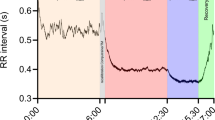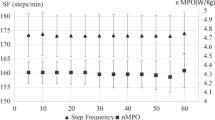Abstract
Purpose
Assessment of heart rate variability (HRV) during exercise is an emerging area of study. Measurements of HRV are characterized by domain (time, frequency, and nonlinear) or time scale (short or long-term). The purpose of this study was to compare methods of HRV analysis during submaximal running before and after 18 weeks of marathon training.
Methods
Pre and post-training, 42 recreational runners (21.1 ± 1.5 years, 28 f) completed a 2-mile (3218 m) time trial (2MI) and a submaximal run (SUBMAX) at 75% of 2MI speed. Changes in HRV during SUBMAX and physiological measures were assessed with paired samples t tests. Correlations between the changes of selected variables were assessed with Spearman’s rho.
Results
Long-term measures of HRV did not change with training, while several short-term measures changed: Poincaré plot SD1 (PPSD1) (2.9 ± 0.9, 3.5 ± 1.5; p = 0.049), PPSD1.PPSD2−1 (0.23 ± 0.11, 0.29 ± 0.17; p = 0.047) and Detrended Fluctuation Analysis α1 (0.95 ± 0.25, 0.82 ± 0.28; p = 0.006). Both 2MI (15.6 ± 2.0 min, 14.2 ± 1.7 min; p ≤ 0.001) and VO2max (50.6 ± 7.6, 52.7 ± 7.3; p = 0.049) improved with training. Change in sample entropy (SampEn) was correlated with change in 2MI (rho = − 0.379, p = 0.016), suggesting an association between this measure of HRV and endurance performance.
Conclusions
Measures of short-term HRV change with marathon training and may reflect adaptation independent of change in aerobic capacity.

Similar content being viewed by others
Data availability statement
The datasets generated during and/or analysed during the current study are available from the corresponding author on reasonable request.
References
Seely AJE, Macklem PT (2004) Complex systems and the technology of variability analysis. Crit Care 8:R367–R384. https://doi.org/10.1186/cc2948
Goldberger AL, Hausdorff JM, Stanley HE (2002) Fractal dynamics in physiology: alterations with disease and aging. Proc Natl Acad Sci USA 99:2466–2472
Blain G, Meste O, Blain A, Bermon S (2009) Time-frequency analysis of heart rate variability reveals cardiolocomotor coupling during dynamic cycling exercise in humans. Am J Physiol Heart Circ Physiol 296:H1651–H1659. https://doi.org/10.1152/ajpheart.00881.2008
Nomura K, Takei Y, Yoshida M, Yanagida Y (2006) Phase-dependent chronotropic response of the heart during running in humans. Eur J Appl Physiol 97:240–247. https://doi.org/10.1007/s00421-005-0103-7
Sandercock GRH, Brodie DA (2006) The use of heart rate variability measures to assess autonomic control during exercise. Scand J Med Sci Sports 16:302–313
Sornmo L, Bailon R, Laguna P (2022) Spectral analysis of heart rate variability in time-varying conditions and in the presence of confounding factors. IEEE Rev Biomed Eng. https://doi.org/10.1109/RBME.2022.3220636
Richman JS, Moorman JR (2000) Physiological time-series analysis using approximate entropy and sample entropy. Am J Physiol Heart Circ Physiol 278:H2039–H2049. https://doi.org/10.1152/ajpheart.2000.278.6.H2039
Yentes JM, Hunt N, Schmid KK et al (2013) The appropriate use of approximate entropy and sample entropy with short data sets. Ann Biomed Eng 41:349–365. https://doi.org/10.1007/s10439-012-0668-3
Peng CK, Havlin S, Stanley HE, Goldberger AL (1995) Quantification of scaling exponents and crossover phenomena in nonstationary heartbeat time series. Chaos 5:82–87. https://doi.org/10.1063/1.166141
Tulppo MP, Makikallio TH, Takala TE et al (1996) Quantitative beat-to-beat analysis of heart rate dynamics during exercise. Am J Physiol Heart Circ Physiol 271:H244–H252. https://doi.org/10.1152/ajpheart.1996.271.1.h244
Mourot L, Bouhaddi M, Perrey S et al (2004) Quantitative Poincaré plot analysis of heart rate variability: effect of endurance training. Eur J Appl Physiol 91:79–87. https://doi.org/10.1007/s00421-003-0917-0
Brennan M, Palaniswami M, Kamen P (2001) Do existing measures of Poincare plot geometry reflect nonlinear features of heart rate variability? Biomed Eng IEEE Trans 48:1342–1347. https://doi.org/10.1109/10.959330
Michael S, Graham KS, Davis GMO (2017) Cardiac autonomic responses during exercise and post-exercise recovery using heart rate variability and systolic time intervals-a review. Front Physiol 8:301. https://doi.org/10.3389/fphys.2017.00301
No authors listed (1996) Heart rate variability: standards of measurement, physiological interpretation and clinical use. Task force of the European Society of Cardiology and the North American Society of Pacing and Electrophysiology. Circulation 93(5):1043–1065. PMID: 8598068
Bravi A, Longtin A, Seely AJ (2011) Review and classification of variability analysis techniques with clinical applications. Biomed Eng Online 10:90–90. https://doi.org/10.1186/1475-925X-10-90
Heffernan KS, Sosnoff JJ, Fahs CA et al (2008) Fractal scaling properties of heart rate dynamics following resistance exercise training. J Appl Physiol 105:109. https://doi.org/10.1152/japplphysiol.00150.2008
Mourot L, Bouhaddi M, Perrey S et al (2004) Decrease in heart rate variability with overtraining: assessment by the Poincare plot analysis. Clin Physiol Funct Imaging 24:10–18
Plews D, Laursen P, Stanley J et al (2013) Training adaptation and heart rate variability in elite endurance athletes: opening the door to effective monitoring. Sport Med 43:773–781. https://doi.org/10.1007/s40279-013-0071-8
da Silva VP, de Oliveira NA, Silveira H et al (2015) Heart rate variability indexes as a marker of chronic adaptation in athletes: a systematic review. Ann Noninvasive Electrocardiol 20:108–118. https://doi.org/10.1111/anec.12237
Bellenger CR, Fuller JT, Thomson RL et al (2016) Monitoring athletic training status through autonomic heart rate regulation: a systematic review and meta-analysis. Sports Med 46:1461–1486. https://doi.org/10.1007/s40279-016-0484-2
Buchheit M, Chivot A, Parouty J et al (2010) Monitoring endurance running performance using cardiac parasympathetic function. Eur J Appl Physiol 108:1153–1167. https://doi.org/10.1007/s00421-009-1317-x
Perini R, Orizio C, Baselli G et al (1990) The influence of exercise intensity on the power spectrum of heart rate variability. Eur J Appl Physiol Occup Physiol 61:143–148. https://doi.org/10.1007/BF00236709
Pichon AP, De Bisschop C, Roulaud M et al (2004) Spectral analysis of heart rate variability during exercise in trained subjects. Med Sci Sports Exerc 36:1702–1708. https://doi.org/10.1249/01.MSS.0000142403.93205.35
McNarry MA, Lewis MJ (2012) Heart rate variability reproducibility during exercise. Physiol Meas 33:1123–1133. https://doi.org/10.1088/0967-3334/33/7/1123
Voss A, Schulz S, Schroeder R et al (2009) Methods derived from nonlinear dynamics for analysing heart rate variability. Philos Trans Ser A, Math Phys Eng Sci 367:277–296. https://doi.org/10.1098/rsta.2008.0232
Henriques T, Ribeiro M, Teixeira A et al (2020) Nonlinear methods most applied to heart-rate time series: a review. Entropy. https://doi.org/10.3390/e22030309
Rogers B, Berk S, Gronwald T (2022) An index of non-linear HRV as a proxy of the aerobic threshold based on blood lactate concentration in elite triathletes. Sport 10:25
Rogers B, Giles D, Draper N et al (2021) A new detection method defining the aerobic threshold for endurance exercise and training prescription based on fractal correlation properties of heart rate variability. Front Physiol 11:1806
Shaffer F, McCraty R, Zerr CL (2014) A healthy heart is not a metronome: an integrative review of the heart’s anatomy and heart rate variability. Front Psychol 5:1040. https://doi.org/10.3389/fpsyg.2014.01040
Ernst G (2017) Heart-rate variability-more than heart beats? Front Public Heal 5:240. https://doi.org/10.3389/fpubh.2017.00240
Brozek J, Grande F, Anderson JT, Keys A (1963) Densitometric analysis of body composition: revision of some quantitative assumptions. Ann N Y Acad Sci 110:113–140. https://doi.org/10.1111/j.1749-6632.1963.tb17079.x
Binder RK, Wonisch M, Corra U et al (2008) Methodological approach to the first and second lactate threshold in incremental cardiopulmonary exercise testing. Eur J Cardiovasc Prev Rehabil Off J Eur Soc Cardiol Work Groups Epidemiol Prev Card Rehabil Exerc Physiol 15:726–734. https://doi.org/10.1097/HJR.0b013e328304fed4
Hernando D, Garatachea N, Almeida R et al (2018) Validation of heart rate monitor polar RS800 for heart rate variability analysis during exercise. J strength Cond Res 32:716–725. https://doi.org/10.1519/JSC.0000000000001662
Rogers B, Giles D, Draper N et al (2021) Influence of artefact correction and recording device type on the practical application of a non-linear heart rate variability biomarker for aerobic threshold determination. Sensors. https://doi.org/10.3390/s21030821
Tarvainen MP, Niskanen J-P, Lipponen JA et al (2014) Kubios HRV–heart rate variability analysis software. Comput Methods Programs Biomed 113:210–220. https://doi.org/10.1016/j.cmpb.2013.07.024
Saville DJ (1990) Multiple comparison procedures: the practical solution. Am Stat 44:174–180. https://doi.org/10.1080/00031305.1990.10475712
Keselbrener L, Akselrod S (1996) Selective discrete Fourier transform algorithm for time-frequency analysis: method and application on simulated and cardiovascular signals. IEEE Trans Biomed Eng 43:789–802. https://doi.org/10.1109/10.508542
Coronado A, Carpena P (2005) Size effects on correlation measures. J Biol Phys 31:121–133. https://doi.org/10.1007/s10867-005-3126-8
Delignieres D, Ramdani S, Lemoine L et al (2006) Fractal analyses for “short” time series: a re-assessment of classical methods. J Math Psychol 50:525–544. https://doi.org/10.1016/j.jmp.2006.07.004
Solís-Montufar EE, Gálvez-Coyt G, Muñoz-Diosdado A (2020) Entropy analysis of RR-time series from stress tests. Front Physiol. https://doi.org/10.3389/fphys.2020.00981
Platisa MM, Gal V (2006) Reflection of heart rate regulation on linear and nonlinear heart rate variability measures. Physiol Meas 27:145–154. https://doi.org/10.1088/0967-3334/27/2/005
Cerutti S, Hoyer D, Voss A (2009) Multiscale, multiorgan and multivariate complexity analyses of cardiovascular regulation. Philos Trans R Soc London A 367:1337–1358. https://doi.org/10.1098/rsta.2008.0267
Nuuttila O-P, Nummela A, Häkkinen K et al (2021) Monitoring training and recovery during a period of increased intensity or volume in recreational endurance athletes. Int J Environ Res Public Health 18:2401
Lipsitz LA (2002) Dynamics of stability: the physiologic basis of functional health and frailty. J Gerontol A Biol Sci Med Sci 57:B115–B125. https://doi.org/10.1093/gerona/57.3.b115
Biltz GR, Lundstrom CJ, Uithoven K (2016) Initial submaximal RER and tidal volume variability appear inversely related to direction of response to marathon training. Pediatr Exerc Sci 28:32. https://doi.org/10.1123/pes.2016.0242
Jamnick NA, Pettitt RW, Granata C et al (2020) An examination and critique of current methods to determine exercise intensity. Sports Med 50:1729–1756. https://doi.org/10.1007/s40279-020-01322-8
Sacha J (2014) Interaction between heart rate and heart rate variability. Ann noninvasive Electrocardiol 19:207–216. https://doi.org/10.1111/anec.12148
Acknowledgements
The authors would like to express their gratitude to the study participants, and to the students who assisted in the gathering and management of the data.
Author information
Authors and Affiliations
Contributions
Conceptualization, CL, GB, KU and ES; methodology, CL, GB, and KU; validation, CL; formal analysis, CL; investigation, CL, KU; resources, GB, E.S.; data curation, CL.; writing—original draft preparation, CL.; writing—review and editing, CL, GR, KU, ES; visualization, CL; supervision, ES. All authors have read and agreed to the published version of the manuscript.
Corresponding author
Ethics declarations
Conflict of interest
The authors have no competing interests to declare that are relevant to the content of this article.
Human and animal rights
This study and all procedures were in accordance with the ethical standards of the institution and with the 1964 Helsinki declaration and its later amendments or comparable ethical standards. It was approved by the Institutional Review Board at the University of Minnesota—Twin Cities.
Informed consent
All participants provided written, informed consent after being informed about the protocol and purpose of the study.
Additional information
Publisher's Note
Springer Nature remains neutral with regard to jurisdictional claims in published maps and institutional affiliations.
Rights and permissions
Springer Nature or its licensor (e.g. a society or other partner) holds exclusive rights to this article under a publishing agreement with the author(s) or other rightsholder(s); author self-archiving of the accepted manuscript version of this article is solely governed by the terms of such publishing agreement and applicable law.
About this article
Cite this article
Lundstrom, C.J., Biltz, G.R., Uithoven, K.E. et al. Effects of marathon training on heart rate variability during submaximal running: a comparison of analysis techniques. Sport Sci Health 20, 47–54 (2024). https://doi.org/10.1007/s11332-023-01062-y
Received:
Accepted:
Published:
Issue Date:
DOI: https://doi.org/10.1007/s11332-023-01062-y




